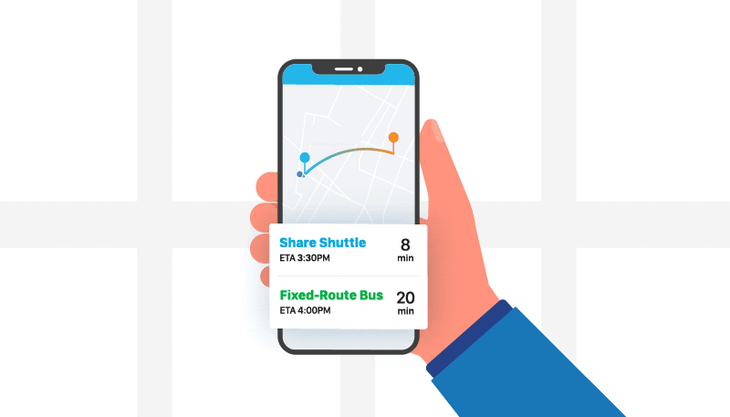Originally published July 20, 2022. Updated January 3rd, 2024.
Need a primer on some of the terms used below? Check out our glossary for all of the TransitTech definitions you could ever need — and then some.
We know that transit plays a critical role in getting people to work and stimulating economic growth: APTA estimates that for every $1 invested in transit, communities see $5 in economic returns. Much of our cities’ infrastructure is built to facilitate movement to and from areas dense with jobs: commuter rail lines taking suburban passengers into the heart of cities, highways built to accommodate rush hour traffic.

But what happens when job concentrations change, and traditional transit infrastructure struggles to catch up to new demand patterns? Communities across the country are turning to a more flexible transit option: microtransit services to connect workers to jobs in lower-density areas, or jobs with overnight shifts.
Why conventional public transit falls short.
Nearly four years past the initial COVID-19 shutdowns of early 2020, major cities are still struggling to rent formerly-packed office spaces in downtown cores. Meanwhile, new job centers that sprung up in outlying areas are hiring, and changing the landscape of job availability — particularly for shift-based industrial work.
These workers may be able to use public transit to get close to their new jobs, but are then left to manage the last few miles on their own. Walking is always an option, but one that is simultaneously time-consuming, exhausting (who wants to show up to work already tired?), and unsafe depending on time of day and weather. And while some cities have express bus routes into industrial areas, they typically run from 8am to 5pm, which is not helpful for shift workers — especially those working overnight.
So why haven’t cities and transit agencies extended their fixed-route networks to better meet these workers’ needs? Because infrastructure-heavy public transit projects, such as new or extended bus routes or light rail, are expensive line items for cash-strapped cities to justify.
Where microtransit can help.
As a result, more communities are exploring microtransit, which can be launched quickly, adjusted easily as conditions change, and can offer service at a lower cost-per-trip than fixed-route in lower-density areas.
In 2022, MobiliSE — a nonprofit organization dedicated to improving transportation in Southeast Wisconsin — collaborated with the University of Wisconsin-Milwaukee and the Southeastern Wisconsin Regional Planning Commission to test the hypothesis that flexible microtransit services could foster strong connections to jobs.

Though employment is plentiful in the Menomonee Falls/Butler region just outside Milwaukee, transit options are slim — and employers in the region struggle to fill jobs. The microtransit service FlexRide is targeted toward Milwaukee residents who want or hold jobs in Menomonee Falls/Butler, and provides cost-effective transportation between the locations. Employers themselves have promoted the service, which helped with employee acquisition and retention. What began as a short-term pilot has grown into a long-term success story, serving 5,400 unique commuters in a service that has secured funding through 2024.
Pace Suburban Bus, the transit agency serving Chicagoland suburbs, recently launched a similar program targeting third-shift workers near O’Hare Airport and in the town of Harvey. Pace Connect, as the service is called, operates overnight to connect job centers to Pace and Chicago Transit Authority (CTA) fixed-route networks. Pace Connect helps workers navigate a safe, affordable commute at hours when other forms of transit are less available. With wait times of 6 minutes on average, the service has proven reliable and convenient in its initial weeks.
Programs like these demonstrate just how easy it can be to choose more flexible public transit solutions that do not require huge budgets or multi-year implementation plans. And the expected boost in economic development could help communities do even more to address transit equity while improving public transit for all.
Interested in learning more? Find time to talk with our team.

Via Resource Editor




